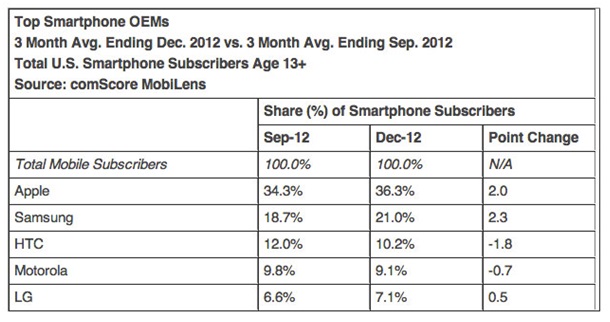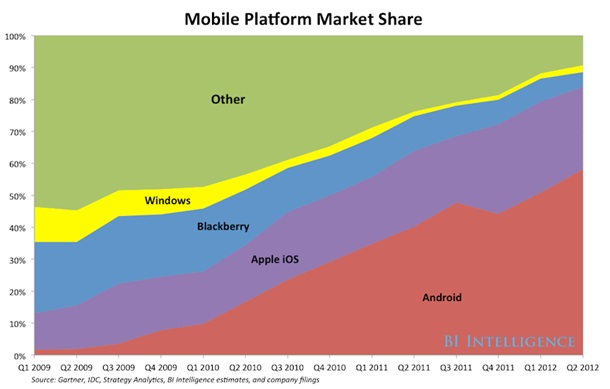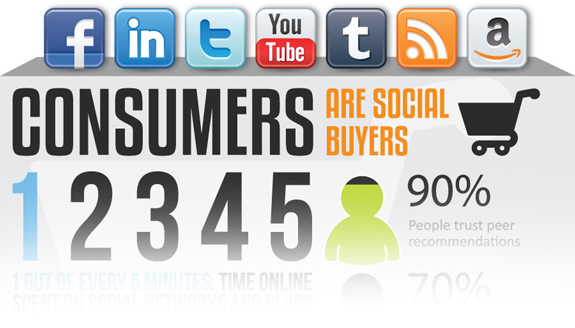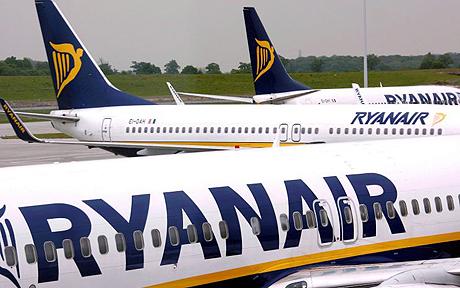Apple’s Position in the United States Smartphone Market
The smartphone market in the United States is comprised of all firms that manufacture and sell smartphone’s specifically to U.S. consumers. According to Cromar (2010. p 4.), a smartphone is a mobile phone which is run on an advanced operating system. The operating system makes a smartphone to have advanced computing capabilities such as installing of new applications and can connect to the internet.
There are five major players in the U.S. smartphone market. They include:
- Apple Inc. (a U.S. corporation)
- Research in Motion Limited (a Canadian corporation)
- HTC Corporation (a Taiwanese corporation)
- Motorola Inc. (a U.S. corporation)
- Samsung Electronics (a subsidiary of a Korean corporation)
This article will mainly focus on Apple’s presence in the smartphone market.
Apple’s Market Share
According to new statistics released by comScore – an analytics firm – on February 2013, Apple and Samsung have continued their two-horse race for the U.S. smartphone subscription over the last quarter of 2012 (Campblell, 2013). For three months ending in December 2012, Apple’s iPhone had maintained its dominance in the U.S. smartphone market which raised its share of the market by 2% up from 36.3% in the previous quarter. However, Samsung, the biggest competitor to Apple had experienced the most positive change over the same period by controlling 21% of the market. These two smartphone giants were trailed by HTC and Motorola, which unfortunately were experiencing declining results with market shares of 10.2% and 9.1% respectively (Campbell, 2013). The following table shows a percentage share of smartphone subscribers for the period between September 2012 and December 2012

Source: comScore (2013)
This was a representation of 125.9 million people in the United States who were owning smartphones during the last quarter of 2012 (Jones 2013). As Apple was dominating in smartphone subscription, Google’s Android Platform operating system was leading with a 53.4 % of the market share in the fourth quarter of 2012 (Paul, 2013). This made Apple’s iPhone 5 and Samsung Galaxy SIII the bestseller in Q4 leaving HTC, LG and RIM struggling to get a share of the lucrative market. The following table according to Jones (2013) shows a tabulation of Apple’s position in the period between December 2011 and December 2012
| Dec-11 | Mar-12 | Jun-12 | Sep-12 | Dec-12 | +/- | |
| Android | 47% | 51% | 52% | 53% | 53% | 6% |
| Apple | 30% | 31% | 32% | 34% | 36% | 6% |
| RIMM | 16% | 12% | 11% | 8% | 6% | -10% |
| Microsoft | 5% | 4% | 4% | 4% | 3% | -2% |
| Symbian | 1% | 1% | 1% | 1% | 1% | -0% |
| Other | 1% | 1% | 1% | 1% | 0% | -1% |
| Total | 100% | 100% | 100% | 100% | 100% |
Source: comScore (2013)
Threat Analysis
Apple’s dominance in the smartphone market for many years can be attributed to the advantage that the company takes from vital synergies that are available in its electronic ecosystem of electronics, computers and software (Comar 2012 p 31). Before the company released the iPhone, Apple already had an existing broad base of users for its iPods, computers and software like iTunes. The iPhone is a smartphone that can be easily integrated with other Apple products such as the Apple TV. It is the success of Apple’s other products that were carried over and integrated into the iPhone making it an unmatched smartphone with highly differentiated and integrated user experience.
As of 2010, most of Apple’s competitors were facing significant challenges in market share control due to Apple’s availability of a highly integrated electronic ecosystem. However, Samsung has in the past two years revolutionized its smartphone presence in the United States making it Apple’s main competitor. This has led to patent counter suits between Apple and Samsung being experienced in especially the last one year. Samsung has fully utilized its wide range of consumer products such as the manufacture of computer chips, PCs, TVs and printer to influence its smartphone innovation in recent years, a technique that Apple largely relied on in the earlier days.
Apple’s Weaknesses
The biggest challenge that Apple as a smartphone manufacture is facing today is the growing competition in smartphone operating system application platform. Apple smartphones use iOS which is a mobile operating system created exclusively by Apple. Over the last couple of years, Apple has been experiencing a significant long term risk in gradual loss of smartphone market share specifically to the Android platform. This trend has reduced Apple, a one-time smartphone giant, to a mere niche player in the U.S. smartphone market. The following image show’s Apple’s iOS market share as compared to other mobile operating systems for the period between January 2009 and June 2012 (Blodget 2012)

The Android platform that is giving Apple’s iOS a run for its money is a software stack of mobile devices which includes an operating system that is designed mainly for touch screen devices such as smartphones. Android, which is owned by Google, has played a key role in challenging the success of Apple’s smartphone by handing companies like Samsung an easy to use mobile operating system.
The reason why Apple’s smartphone market share is under siege is essentially because the smartphone market is a ‘platform’ market. Apple’s weakness here is that in a platform market, third company markets like Google build products and services on top of other companies’ platforms (Blodget 2012). In this case, Google continues to build the Android application for use by companies such as Samsung on their smartphones. Currently, Android and Apple are continuing to dominate the smartphone market with Apple’s share declining in a rapid manner in the last two years.
Another area of Apple’s weakness is its spending on research. According to Chen (2013), smartphone manufacturer, Samsung, outspent Apple by 2012 on research and development with Samsung spending 5.7% of its revenues on research as compared to Apple which has spent only 2.2% of its revenues. Research is essential, especially in a mobile based platform, since a company will always be abreast with not only emerging trends, but also reading the current trends of consumers.
Samsung’s Competition on Apple
Even though Samsung came in second in the U.S. smartphone market share, Samsung was the only company that recorded significant growth especially in the last quarter of 2012. Paul (2013) points out that with increase in competition in innovativeness in smartphone design, Samsung’s growth rate was slightly more than Apple’s which consequently heightens the prediction of its market share results in the first quarter of 2013. Samsung has not only been experiencing growth as a mobile phone manufacturer in the United States alone. Globally, for the first time in 13 years, Samsung toppled Nokia in the global mobile phone business on an annual basis at the end of 2012. Samsung accounted a growth of 29% in mobile phone business in 2012 which was up from 24% in 2011 (Wayne 2012).
Chen (2013) also concurs that for many years Apple has not face a challenger like Samsung, who can make very popular and profitable smartphones and tablets. Whereas Apple is staking its success on creating new markets and then dominating them, Samsung is investing heavily on studying existing markets and coming up with new innovations inside them. Samsung’s strategy has seen the Samsung Galaxy SIII smartphone to be the first smartphone to engage on a neck-to-neck competition with Apple’s iPhone in sales (Chen 2013).
Samsung’s success over competitors like Apple and Nokia is being mainly forged by the company’s competitive edge in the smartphone sector. According to information and analytics provider HIS, on a global perspective, Apple and Samsung ended 2011 in an absolute two-horse race over smartphone market share, with only 1% separating the two (Wayne 2012) .
Business Analysis tools and techniques
There are many business analysis techniques and tools that can be used to analyze different business problems. This paper shall focus on four of the majorly used tools. They include:
- SWOT Analysis
- The PESTLE Technique
- The 5 Whys Technique
- CATWOE Analysis
SWOT Analysis
SWOT analysis is one of the most commonly used tools for analyzing and auditing the overall strategic position of a business and its environment. SWOT is an acronym that stands for Strengths, Weaknesses, Opportunities and Threats. For purposes of understanding the business environment of a company through SWOT analysis, strengths and weaknesses mainly focus on the internal factors while opportunities and threats focuses on the external factors.
Whereas a business cannot change the external factors affecting it, it can change the internal factors affecting its business environment. SWOT analysis do help companies for instance to understand the external environment of a business and how they can strategize on sustainability and performance. SWOT also helps a company to identify a strategy that creates a concrete business model that best matches a company’s capabilities and resources to the environmental requirements. It is basically a foundation in which a business evaluates its internal potential and probable limitations in comparison to opportunities and threats posed by its external environment. Arguably, a consistent SWOT analysis of the environment that a business is operating enables a company to adequately predict changes in trend and also helps in factoring them in the decision making processes of the company.
Strengths
The strengths of a business are the unique qualities that enable a company, for instance, to accomplish its mission and vision. They form the basis on which the continued successes of a business are established and sustained. The strengths of a business are what the business is well specialized in or the expertise it has, the traits and the exceptional qualities that its employees poses and the distinctive features as compared to others in the industry that gives the business its consistency. They are simply the attributes within a company, which can either be tangible or intangible that give the business a competitive edge over others. Some of these beneficial aspects of a business may include: customer goodwill to the brand loyalty, human competencies, financial resources, products and services, etc.
Weaknesses
Weaknesses are the attributes and qualities that prevent a business from accomplishing its mission and consequently achieving its desired full potential. In SWOT analysis, these are factors that prevent a business from achieving successful results since they simply deteriorate a business’ growth. They are internal factors in a business that make the business not to meet the required standards that the business opts to be meeting. They may range from insufficient research and development capabilities as in the case of Apple Inc. when compared to Samsung Electronics, to narrow product range and depreciating machinery. Analyzing weakness assists the management in a business to know the areas in the business that need to be improved. Weaknesses precisely impact on the profitability of a business and if not well controlled, they may make a company to go out of the business.
Opportunities
Opportunities are essentially the possibilities that a business has in increasing their profit margins or improving on performance. They are presented by the environment within which a business is operating. Opportunities arise when a business takes an advantage of the conditions posed in its operating environment to plan and execute strategies that could drive it to more profit making. Businesses have to be very keen in identifying opportunities and grasping them immediately they rise. It could be something as simple as releasing a new product line to targeting a new customer niche. Conducting a SWOT analysis on opportunities involves examining external factors to a business such as technological advancements and the state of the overall economy.
Threats
Threats to a business rise when external factors in a business environment compromise the profitability and reliability of the business. They create a vulnerability that is faced by a business when compounded to its weaknesses. They are peculiar external factors which cannot be controlled. For instance, the economic downturn of 2008 was factor that most businesses could not control. Political and social trends can also be possible threats to a business. A good example is the current social and political push for products that are more environment friendly as compared to those that are not. An essential part in analyzing the threats of a company has to involve a look at the strengths of its competitors.
SWOT analysis is advantageous in that it presents valuable information since a business can evaluate the four elements either independently or as in combination (Nordmeyer, 2010). It also involves the integration of qualitative and quantitative data which is an essential part in formulating a business strategy. SWOT analysis is preferred by many since one is not required either have technical skills or training to conduct the analysis. This in turn makes SWOT analysis one of the most affordable business analysis tools that also requires a fairly short time to conduct.
The PESTLE Technique
The PESTLE technique is a business analysis technique that is mainly concerned with the external aspects of a business such as the environment. PESTLE is an acronym that stands for Political, Economic, Social, Technological and Legal Environment (Financez 2012). This method is mostly used in analyzing a business environment and making market evaluations at the initial stages of the business. According to Marx (2010), the PESTLE technique primarily consists of four main phases. These phases are:
- Formulating the external factors list
- Identifying the implications of these external factors
- Determining the relative importance of the impacts of the external factors
- Formulating alternative scenarios
Political – When generating a political-factor list, one is expected to concentrate on the key political factors that will affect a business. The taxation policy, for instance, especially during elections is one of the main political factors that a business needs to internalize and factor in its strategy analysis. How foreign policy will affect exports and imports especially to a business in such a field can also be a cognizant factor.
Economic – In this analysis, one is considered to factor the overall economic situation, the strength of consumer spending in business’ main product and service segment, both current and future government expenditure and how it may affect the economy among many other factors.
Social – When considering the sociological aspects in business analysis, it is important to concentrate on the cultural aspects that are likely to impact on the business (Marx 2010). Cultural and social trends have great influences on a consumer of any product or service. Therefore, it is important to consider factors on demography, lifestyle patterns, fashion, and work attitudes as well as religious and ethnic differences when analyzing a business environment.
Technological – This is one area that has greatly changed the lives of many people today. For a business to easily sustain itself in today’s world, it has to adequately factor technological advancements available to improve its overall performance. Having a big eye on technology is a major factor that creates a competitive edge of a business over its rivals (Financez, 2012).
Legal – Legal and political factors are closely related but for good business analysis, they are distinguishable. Current and pending legislation ultimately do have implications on a business which makes them a compulsory business analysis consideration as this technique provides. Legislation may affect employment, taxation, health and safety requirement, as much as many other aspects of a business.
Environmental – These are factors in business analysis that may have a connection with the environment. Aspects on pollution capabilities and recycling possibilities in the product and services of a company are important factors in business analysis.
The 5 Whys Technique
The 5 Whys technique is a problem-solving technique that assists one in getting to the root cause of a problem quickly (Manktelo & Carlson 2011). This method simply helps in determining the cause-effect relationship in a problem or failure event (Sondalini 2008). This technique was made popular by Toyota especially in the 1970s when they were developing their manufacturing methodology. The 5 Why’s technique simply involves looking at a business problem and asking ‘why’ and ‘what caused the problem’. In using this strategy to solve a problem, one simply starts with the end results and works backward in asking ‘why’ in a repeated manner until the root cause of a problem is apparent.
Five is a rule of the thumb and that is why this technique is called the 5 Whys technique. It is not a must for one to ask 5 ‘whys’ since one may ask more or less before finding the root cause of the problem. When one, for instance, in business is facing a certain problem, you start with a statement of the situation and ask why it is occurring. Then turn the answer to this questions into a second ‘Why’ question. The answer to the second ‘Why’ questions becomes the third ‘Why’ questions and so forth. Repeatedly asking why peels away ‘layers’ in an issue which then leads one to the root cause of a problem. When one refuses to be satisfied with an answer, this increases the odds of coming up with the underlying root cause of the problem (Sondalini 2008). Some of the benefits attributed to this technique are:
- Simple – it does not require the use of advanced mathematical tools.
- Effective – it quickly helps to separate symptoms from causes
- Flexible – It can be used alone or in combination with other techniques
CATWOE Analysis
CATWOE analysis is a business analysis technique where an analyst prepares a report, that is analytical, to solve a particular problem. CATWOE is an acronym that stands for Clients, Actors, and Transformation, Worldview, Owner and Environmental constraints. In business, it is a technique that is very useful in checking the features existing in a defined problem. The CATWOE technique is mostly preferred when identifying a business problem that requires prompting critical thinking on why it is really necessary to be solved.
Clients – The clients of a business have to be analyzed on so as to understand who are on the receiving end of the business’s products and services.
Actors – This comprises the employees who form part of implementing the business strategy or changes to achieve a desired mission.
Transformation – It comprises of an analysis of probable changes that have been introduced in a business. It also factors on the analysis of the processes involved in transforming inputs into outputs.
Worldview – In other words, this is the world view. This describes an analysis on the bigger picture that a certain situation or a problem in business fits.
Owner – Having a look on the stakeholders and identifying needs of the owners or shareholders of a business is crucial.
Environmental constraints – It includes an analysis on the external environmental factors in which a business is operating.
References
Blodget H. (2012). This Trend is very worrisome for Apple. Business Insider
Campbell M. (Wednesday, 6th February 2013). Apple and Samsung pull further ahead in U.S. smartphone market, iOS gains on Android. Apple Insider
Chen B. (February 10th, 2013). Samsung Emerges as a Potent Rival to Apple’s Cool. New York Times
Comar S. (November 29th, 2010). Smartphone in the U.S. Market Analysis
ComScore (February 6th 2013). ComScore Reports December 2012 U.S. Smartphone Subscriber Market Share
Financez (2012). What is Business Analysis: 2 – PESTLE Technique
Jones C. (February 2013). Apple’s and Android’s U.S. Smartphone Market Share Continues to Increase.
Manktelow J. & Carlson A. (2011). 5 Whys – Quickly getting to the root of a problem. Mind Tools
Marx C. (July 20th, 2010). The PESTLE Strategic Marketing Analysis Technique: Compiling the list of External Factors. Yahoo! Voices
Nordmeyer B. (2010). Advantages and Disadvantages of SWOT Analysis. Houston Chronicle.
Paul C (2013). Apple top US smartphone market with Samsung second. TechBeat.
Sondalini M. (2008). Understanding how to use the 5 Whys for Root Cause Analysis. Lifetime Readability Solutions
Wayne (December 18th, 2012). Samsung displaces Nokia as Top Cellphone Brand in 2012 and takes decisive Smartphone lead over Apple. HIS Supplier




